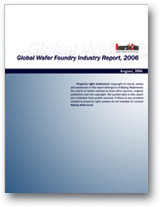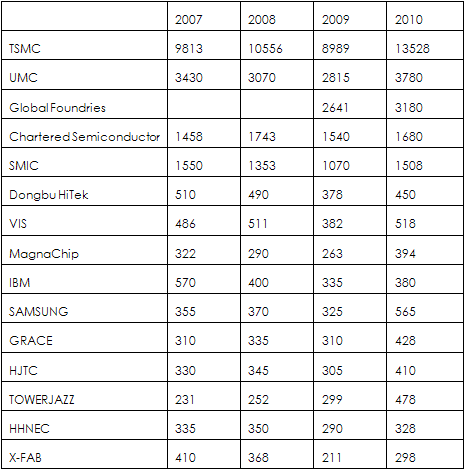|
|
|
报告导航:研究报告—
TMT产业—电子半导体
|
|
2009-2010年全球及中国晶圆代工行业研究报告 |
 |
字数:2.7万 |
页数:117 |
图表数:107 |
|
中文电子版:7000元 |
中文纸版:3500元 |
中文(电子+纸)版:7500元 |
|
英文电子版:2300美元 |
英文纸版:2200美元 |
英文(电子+纸)版:2600美元 |
|
编号:ZYW048
|
发布日期:2010-09 |
附件:下载 |
 |
|
|
2010年是晶圆代工行业自2000年后最好的一年。 预计2010年晶圆代工行业产值为276亿美元,比2009年增长37.8%。整个半导体行业产值预计为2745亿美元,比2009年增长21.5%。
2007-2010年全球15家晶圆代工厂收入统计与预测
2010年晶圆代工行业的突飞猛进,一方面是由于经济形势的好转,另一方面是许多半导体大厂都采取轻晶圆策略(fab-lite)。多数厂商的轻晶圆厂策略是继续利用较旧的晶圆厂,或者在自家晶圆厂生产模拟产品,避免花大钱投资新的晶圆厂。而在先进数字CMOS制程方面,都交给晶圆代工厂。因为65纳米以下制程(Process)的研发非常耗费财力和人力,即便是半导体大厂也无能为力。最佳例子之一是德州仪器宣布32纳米以下制程产品将委托给台积电代工。日本最大的半导体厂家瑞萨也在2010年7月宣布,未来尖端产品委托给台积电代工。未来长时间内,晶圆代工行业都会比半导体行业平均增幅要高。2010年晶圆代工行业也大幅度提高资本支出来提高技术和产能,台积电预计2010年资本支出高达59亿美元,联电达19亿美元,Global Foundries大约25亿美元,都是2009年的3倍左右。 2010年晶圆代工行业也出现了一些大的变化,Global Foundries(简称GF)开始崭露头角。这个脱胎自AMD的晶圆代工厂,自收购特许半导体后开始日益强大。GF的出现打破了晶圆代工业台积电、联电、特许、中芯国际四强纷争的局面。中芯国际开始被远远抛离,营收只有GF的一半,而技术远远落后GF。晶圆代工行业开始呈现三足鼎立的局面。联电面临来自GF的强力挑战,甚至台积电都不敢小觑GF。 GF要想超越联电也并非易事。首先GF收购的特许半导体经营状况一直不佳,2009年净亏损2.88亿美元,而联电2009年运营利润率达5.1%。2009年3季度特许半导体产能利用率为75%,而联电为89%。特许半导体原是新加坡政府主权基金淡马锡主导的企业,效率低下,自成立以来连续多年亏损。中芯国际连续13季度、5年本业亏损,特许半导体比中芯国际强不了多少。而联电则要好得多,连续5年盈利。GF要想把特许半导体改造成高效率的企业要花费一些时日。 其次是GF的技术和产能都无法和联电相提并论。联电有480万片晶圆的年产能,GF的特许拥有大约190万片晶圆的年产能,加上原AMD,估计有350万-380万片。GF虽然背靠阿布扎比这个大财主,但是晶圆产能的提升需要时间,GF的美国新工厂自2009年建设,2012年才能投产。 最后是客户方面,GF的客户范围窄。因为GF要优先照顾母公司AMD这个最大的客户,这使得其它客户会心存芥蒂。而特许半导体是IBM技术联盟的成员,其大客户都是IBM联盟的成员,非IBM联盟的成员很少,其他客户也会有所顾忌。而联电是全球最早的晶圆代工厂,对待客户无论大小和出身,都一视同仁。 至于台积电,成立23年以来运营利润率未低于20%,毛利率未低于30%,市场占有率一直排第一。目前无人能撼动台积电的地位,单其1100万片晶圆的年产能都足够对手花3-5年时间追赶,而台积电更不会停滞不前。2010年59亿美元的支出保证台积电稳稳占据第一的位置,恐怕15年内都无人能撼动。 中国大陆的晶圆代工行业,完全不在意中芯国际的持续亏损。中芯国际连续13季度亏损,2010年2季度依靠超过1亿美元的业外收益而扭亏,实际本业亏损大约1000万美元。中芯国际尽管连续5年亏损,仍然有意再投资建设一条12英寸晶圆生产线。2010年,宏力和华虹NEC投资145亿建设12英寸晶圆生产线。而在2008年建成的武汉新芯12英寸晶圆生产线,其2009年年收入不及台积电上海8英寸厂的八分之一。而深圳也已经建成了8英寸和12英寸晶圆生产线。
The year of 2010 has been the best year for wafer foundry industry since 2000. It is expected that the output value of wafer foundry industry will reach USD27.6 billion, up 37.8% year-on-year. In addition, the output value of the entire semiconductor industry is projected to achieve USD274.5 billion, rising 21.5% year-on-year.
Income of World’s 15 Wafer Foundries, 2007-2010E
 The wafer foundry industry witnessed a prosperous development in 2010, as a result of the economic recovery and the fab-lite strategy adopted by many large semiconductor companies. Most of the companies have continued to use existing fabs or produce analog products in their own fabs instead of investing in new fabs, while outsourcing the advanced digital CMOS process to wafer foundries because the R&D of processes at 65-nm and below that requires a huge amount of capital and labor force is unaffordable even to large semiconductor companies. For example, TI announced to outsource the production of the products at 32-nm and below to TSMC. Renesas, Japan’s biggest semiconductor manufacturer, also announced to outsource the production of its future top-class products to TSMC in July 2010. Thus, the wafer foundry industry will see a higher average growth margin than that of the semiconductor industry in the future. In the meantime, the wafer foundry industry also substantially increased the capital expenditure to improve technology and capacity in 2010. The capital expenditure of TSMC, UMC and Global Foundries will be as high as USD5.9 billion, USD1.9 billion and around USD2.5 billion respectively in 2010, all tripling the figures in 2009. In 2010, there were some big changes in the wafer foundry industry. Global Foundries (GF), the wafer foundry originated from AMD, became increasingly strong after acquiring Chartered Semiconductor. The emergence of GF ended the competitive structure formed by TSMC, UMC, Chartered Semiconductor and SMIC. SMIC had been lagged far behind, and the operating income was only half of GF’s, and its technology was much inferior to GF’s as well. As a result, the wafer foundry industry is being dominated by GF, UMC and TMSC. UMC is facing the powerful challenge from GF, and even TMSC dare not underestimate GF. Nevertheless, it is not easy for GF to surpass UMC as well. Firstly, Chartered Semiconductor acquired by GF had delivered poor performance all the while, and suffered net losses of USD288 million in 2009, while UMC achieved an operating profit margin of 5.1% in 2009. In 2009Q3, the capacity utilization of Chartered Semiconductor was 75%, while UMC’s was 89%. Originally led by Temasek, a sovereign wealth fund of the Singapore government, Chartered Semiconductor has been operating with low efficiency and suffered losses since its establishment. SMIC has suffered losses for main businesses for 13 consecutive quarters and five years. Chartered Semiconductor has not done better than SMIC. UMC has operated much better, and gained profit for five consecutive years. It will take GF a long time to transform Chartered Semiconductor into an efficient enterprise. Secondly, GF cannot compete with UMC in terms of technology and capacity. UMC is capable of producing 4.8 million wafers annually, GF’s Chartered Semiconductor has an annual capacity of around 1.9 million wafers, plus the capacity of the former AMD, GF’s capacity is estimated to be 3.5-3.8 million wafers in total. Although backed up by Abu Dhabi, GF still needs time to increase capacity, since its new plant under construction in the United States since 2009 won’t be put into production until 2012. Finally, GF has a narrower range of clients, because it should give priority to AMD, its parent company and also its biggest client, which may make other clients discontented. Chartered Semiconductor is a member of IBM technology alliance, so the majority of its big clients are from the alliance as well. UMC is the world’s first wafer foundry, treating all clients equally regardless of size and background. During its 23 years of development, TSMC has never got an operating profit margin below 20% and a gross margin below 30%, and it has topped the market all the time. Its leadership has remained unshakable so far. Its annual capacity of 11 million wafers alone will take its rivals 3-5 years to catch up, and it will not stand still as well. In 2010, TSMC topped the market by virtue of USD5.9 billion of expenditure, and is likely to remain unparalleled for the next 15 years. The wafer foundry industry in mainland China has continued to expand regardless of SMIC’s loss for 13 consecutive quarters. In 2010Q2, SMIC turned loss into profit relying on non-operating income of over USD100 million, and its operating income suffered losses of around USD10 million. Despite of the five-year successive losses, SMIC still plans to build a 12-inch wafer production line. Grace Semiconductor Manufacturing Corporation (Grace) and HHNEC invested RMB14.5 billion to build a 12-inch wafer production line in 2010. In 2009, the revenue of the 12-inch wafer production line completed by Wuhan Xinxin Semiconductor Manufacturing Corporation in 2008 was less than 12.5% of that of TSMC’s 8-inch plant in Shanghai. Meanwhile, Shenzhen also has built 8-inch and 12-inch wafer production lines.
第一章、半导体产业链
1.1、半导体产业链
1.2、晶圆制造
1.3、晶圆成本分析
第二章、半导体下游市场现状与未来
2.1、手机市场
2.2、PC与平板电视市场
第三章、半导体产业现状与未来
3.1、半导体产业概况
3.2、全球半导体地域分布
3.3、晶圆代工
3.4、全球晶圆代工厂横向对比
3.5、半导体设备与材料
第四章、中国半导体市场与产业
4.1、中国半导体市场
4.2、中国半导体产业
4.3、中国晶圆代工及IC设计产业
第五章、晶圆代工厂家研究
5.1、台积电
5.2、联电
5.3、GLOBALFOUNDRIES
5.4、中芯国际
5.5、DONGBU HITEK
5.6、世界先进
5.7、MAGNACHIP
5.8、GRACE
5.9、HHNEC
5.10、ASMC
5.11、TOWERJAZZ
5.12、X-FAB
5.13、华润微电子
5.14、三星电子
1. Semiconductor Industry Chain
1.1 Overview
1.2 Wafer Manufacturing
1.3 Wafer Cost
2. Semiconductor Downstream Market Status Quo & Future
2.1 Cell Phone
2.2 PC & Flat Panel TV
3. Semiconductor Industry Status Quo & Future
3.1 Overview
3.2 Global Semiconductor Layout by Region
3.3 Wafer Foundry
3.4 Horizontal Comparison of Global Wafer Foundries
3.5 Semiconductor Equipment & Materials
4. China’s Semiconductor Market & Industry
4.1 Semiconductor Market
4.2 Semiconductor Industry
4.3 Wafer Foundry & IC Design Industry
5. Key Companies
5.1 TSMC
5.2 UMC
5.3 GLOBAL FOUNDRIES
5.4 SMIC
5.5 DONGBU HITEK
5.6 VIS
5.7 MAGNACHIP
5.8 GRACE
5.9 HHNEC
5.10 ASMC
5.11 TOWERJAZZ
5.12 X-FAB
5.13 CRM
5.14 Samsung Electronics
台湾半导体产业链
台湾半导体产业地域分布
原始晶圆的加工流程图
晶圆植入电路的流程图
8英寸晶圆成本结构分析
2007-2014年全球手机出货量
2007年1季度-2010年2季度每季度全球手机出货量 与年度增幅
2007年1季度-2010年2季度每季度全球手机出货量地域分布
2007年1季度-2010年2季度每季度全球手机出货量技术分布
2006-2010年全球CDMA/WCDMA手机出货量地域分布
2010年1-2季度全球主要手机厂家出货量
2003-2014年全球平板电视出货量
2003-2011年全球半导体产业产值
1999年季度-2010年1季度全球IC出货量与平均价格
2010年2季度全球半导体市场收入地域分布
2005-2014年全球晶圆代工行业产值与增幅
2005年1季度-2010年3季度全球晶圆代工厂家平均先进制程产能利用率
2006-2013年全球晶圆行业客户结构
2004-2014年全球晶圆出货量尺寸分布
2008年1季度-2011年4季度全球晶圆代工厂产能利用率
1997-2011年全球晶圆厂建设项目支出地域分布
1997-2011年全球晶圆工厂设备支出地域分布
1997-2011年全球晶圆工厂设备支出尺寸分布
2007-2011年全球半导体设备市场地域分布
2007-2011年全球半导体设备市场类型分布
1991-2011年全球半导体设备花费所占比例
1987-2011年半导体设备与材料支出额
2005-2009年中国集成电路市场销售额规模及增长率
2009年中国集成电路市场产品结构
2009年中国IC市场应用结构
2010-2012年中国IC市场规模及增长率预测
2008Q1——2010Q2中国集成电路产业销售额规模及增长
台积电组织结构
2004-2010年台积电收入与运营利润率
2004-2010年台积电晶圆(Wafer)出货量与产能利用率
2008年1季度-2010年2季度台积电每季度收入与运营利润率
2009年1季度-2010年2季度台积电产品下游应用分布
2008年3季度-2010年2季度台积电收入节点分布(By Node)
台积电28nm技术路线图
台积电28nm 工艺特性
2001-2010年联电收入与运营利润率
2001-2010年联电出货量与产能利用率
2008年1季度-2010年2季度联电每季度收入与毛利率
2008年1季度-2010年2季度联电每季度收入地域分布
2008年1季度-2010年2季度联电每季度收入节点分布
2008年1季度-2010年2季度联电每季度收入下游应用分布(By Application)
2008年1季度-2010年2季度联电每季度出货量与产能利用率
2000-2009年特许半导体收入与净利率
2008年3季度-2009年3季度特许半导体收入下游应用分布
2008年3季度-2009年3季度特许半导体收入地域分布
2008年3季度-2009年3季度特许半导体收入节点分布
GlobalFoundries全球晶圆厂分布
GlobalFoundries技术路线图
2003-2010年中芯国际收入与运营利润率
2010年上半年中芯国际收入分析
2008年1季度-2010年2季度中芯国际收入与毛利率
2008年1季度-2010年2季度中芯国际每季度收入下游应用分布
2008年1季度-2010年2季度中芯国际每季度收入类型分布
2008年1季度-2010年2季度中芯国际每季度收入客户分布
2008年1季度-2010年2季度中芯国际每季度收入地域分布
2008年1季度-2010年2季度中芯国际每季度收入节点分布
2008年1季度-2010年2季度中芯国际出货量与产能利用率
中芯国际工厂分布
中芯国际技术能力
中芯国际主要客户
2006-2010年Dongbu HiTek收入与运营利润
2004-2011年Dongbu Hitek出货量与产能利用率
2007年2季度-2010年2季度Dongbu Hitek晶圆ASP与EBITDA
Dongbu集团简介
Dongbu Hitek晶圆厂简介
2007-2010年Dongbu Hitek晶圆厂产能
Dongbu Hitek技术路线图
Dongbu Hitek技术特性
2005-2010年VIS收入与运营利润率
2008年2季度-2010年2季度VIS收入与毛利率
2008年2季度-2010年2季度VIS收入节点分布
2008年2季度-2010年2季度VIS收入下游应用分布
2009年1季度-2010年2季度VIS收入产品分布
2008年2季度-2010年2季度VIS出货量与产能利用率
VIS技术特性
VIS技术路线图
2001-2010年MagnaChip收入与毛利率
2005-2010年MagnaChip收入与运营利润率
2004-2010年MagnaChip收入产品分布
2004-2010年MagnaChip收入地域分布
宏力半导体技术路线图
华虹NEC路线图
上海先进半导体未上市前股份结构
上海先进半导体上市后的股份结构
2003-2010年上海先进半导体收入与毛利率
2003-2010年上海先进半导体收入与EBITDA
2006年1季度-2010年2季度每季度上海先进半导体产能利用率
2008年3季度-2010年2季度上海先进半导体收入地域分布
2008年3季度-2010年2季度上海先进半导体收入客户类型分布
2008年3季度-2010年2季度上海先进半导体收入下游应用分布
2008年3季度-2010年2季度上海先进半导体收入晶圆厂分布
2003-2010年TowerJazz收入与毛利润
2004-2009年X-Fab收入与运营利润
2008-2009年华润微电子收入地域分布
2008-2009年华润微电子收入产品分布
2008-2009年华润微电子收入部门分布
2007-2010年全球15家晶圆代工厂收入统计与预测
2009-2010年全球主要晶圆代工厂运营利润率、产能、产量
2008-2010年台积电各工厂产能
2006年1季度、2007年1季度、2009年4季度-2010年3季度联电各工厂产能
2008年3季度-2009年3季度特许半导体晶圆出货量与产能利用率
2008年3季度-2009年3季度特许半导体各工厂产能
中芯国际产能
MAGNACHIP 各晶圆厂一览
2003-2009年华虹NEC收入
2010年2季度上海先进半导体各生产线产能
Taiwan’s Semiconductor Industry Chain
Wafer Implanted Circuit Diagram
8-inch Wafer Cost Structure
Global Cell Phone Shipment, 2007-2014E
World’s Quarterly Cell Phone Shipment & Annual Growth Rate, 2007Q1-2010Q2
World’s Quarterly Cell Phone Shipment by Region, 2007Q1-2010Q2
World’s Quarterly Cell Phone Shipment by Technology, 2007Q1-2010Q2
World’s CDMA/WCDMA Cell Phone Shipment by Region, 2006-2010
Shipment of World’s Key Cell Phone Manufacturers, Q1-Q2, 2010
World’s Flat Panel TV Shipment, 2003-2014E
Output Value of World’s Semiconductor Industry, 2003-2011E
World’s IC Shipment and Average Price, 1999Q1-2010Q1
World’s Semiconductor Market Income by Region, 2010Q2
World’s Foundry Industry Output Value and Growth Rate, 2005-2014E
Average Capacity Utilization of Advanced Process of World’s Foundries, 2005Q1-2010Q3
World’s Wafer Industry Client Structure, 2006-2013E
World’s Wafer Shipment by Size, 2004-2014E
Capacity Utilization of World’s Foundry, 2008Q1-2011Q4E
World’s Wafer Fab Construction Project Expenditure by Region, 1997-2011E
World’s Wafer Fab Equipment Expenditure by Region, 1997-2011E
World’s Wafer Fab Equipment Expenditure by Size, 1997-2011E
World’s Semiconductor Equipment Market by Region, 2007-2011E
World’s Semiconductor Equipment Market by Type, 2007-2011E
Ratio of World’s Semiconductor Equipment Expenditure, 1991-2011E
Semiconductor Equipment and Materials Expenditure, 1987-2011E
China’s IC Market Sales Scale & Growth Rate, 2005-2009
China’s IC Market Product Structure, 2009
China’s IC Market Application Structure, 2009
China’s IC Market Scale & Growth Rate, 2010-2012E
China’s IC Industry Sales Scale & Growth, 2008Q1-2010Q2
TSMC Organization
TSMC Income & Operating Margin, 2004-2010
TSMC Wafer Shipment & Capacity Utilization, 2004-2010
TSMC Quarterly Income & Operating Margin, 2008Q1-2010Q2
TSMC Products Application, 2009Q1-2010Q2
TSMC Income by Node, 2008Q3-2010Q2
TSMC 28nm Technology Roadmap
TSMC 28nm Technique Features
UMC Income & Operating Margin, 2001-2010
UMC Shipment & Capacity Utilization, 2001-2010
UMC Quarterly Income & Gross Profit Margin, 2008Q1-2010Q2
UMC Quarterly Income by Region, 2008Q1-2010Q2
UMC Quarterly Income by Node, 2008Q1-2010Q2
UMC Quarterly Income by Application, 2008Q1-2010Q2
UMC Quarterly Shipment & Capacity Utilization, 2008Q1-2010Q2
Chartered Semiconductor’s Income & Net Profit Margin, 2000-2009
Chartered Semiconductor’s Income by Application, 2008Q3-2009Q3
Chartered Semiconductor’s Income by Region, 2008Q3-2009Q3
Chartered Semiconductor’s Income by Node, 2008Q3-2009Q3
Global Foundries’ Wafer Plants Worldwide
Global Foundries’ Technology Roadmap
SMIC Income & Operating Margin, 2003-2010
SMIC Income, 2010H1
SMIC Income & Gross Profit Margin, 2008Q1-2010Q2
SMIC Quarterly Income by Application, 2008Q1-2010Q2
SMIC Quarterly Income by Type, 2008Q1-2010Q2
SMIC Quarterly Income by Client, 2008Q1-2010Q2
SMIC Quarterly Income by Region, 2008Q1-2010Q2
SMIC Quarterly Income by Node, 2008Q1-2010Q2
SMIC Shipment & Capacity Utilization, 2008Q1-2010Q2
SMIC Plant Layout
SMIC Technology Capability
SMIC Key Clients
Dongbu HiTek Income & Operating Profit, 2006-2010
Dongbu HiTek Shipment & Capacity Utilization, 2004-2011E
Dongbu HiTek Wafer ASP & EBITDA, 2007Q2-2010Q2
Dongbu Overview
Dongbu Hitek Wafer Fabs
Capacity of Dongbu Hitek Wafer Fabs, 2007-2010
Dongbu Hitek Technology Roadmap
Dongbu Hitek Technique Features
VIS Income & Operating Profit Margin, 2005-2010
VIS Income & Gross Profit Margin, 2008Q2-2010Q2
VIS Income by Node, 2008Q2-2010Q2
VIS Income by Application, 2008Q2-2010Q2
VIS Income by Product, 2009Q1-2010Q2
VIS Shipment & Capacity Utilization, 2008Q2-2010Q2
VIS Technique Features
VIS Technology Roadmap
MagnaChip Income & Gross Profit Margin, 2001-2010
MagnaChip Income & Operating Profit Margin, 2005-2010
MagnaChip Income by Product, 2004-2010
MagnaChip Income by Region, 2004-2010
Grace Semiconductor’s Technology Roadmap
Hua Hong NEC’s Roadmap
ASMC Income & Gross Profit Margin, 2003-2010
ASMC Income & EBITDA, 2003-2010
ASMC Quarterly Capacity Utilization, 2006Q1-2010Q2
ASMC Income by Region, 2008Q3-2010Q2
ASMC Income by Client Type, 2008Q3-2010Q2
ASMC Income by Application, 2008Q3-2010Q2
ASMC Income by Wafer Fab, 2008Q3-2010Q2
TowerJazz Income & Gross Profit Margin, 2003-2010
X-Fab Income & Operating Profit, 2004-2009
CRM Income by Region, 2008-2009
CRM Income by Product, 2008-2009
CRM Income by Division, 2008-2009
Income of World’s 15 Foundries, 2007-2010E
Operating Profit Margin, Capacity and Output of World’s Key Foundries, 2009-2010
TSMC Capacity by Plant, 2008-2010
UMC Capacity by Plant, 2006Q1, 2007Q1, 2009Q4 & 2010Q3
Chartered Semiconductor’s Wafer Shipment & Capacity Utilization, 2008Q3-2009Q3
Chartered Semiconductor’s Capacity by Plant, 2008Q3-2009Q3
SMIC Capacity
MAGNACHIP Wafer Fabs
HHNEC Income, 2003-2009
ASMC Capacity by Production Line, 2010Q2
如果这份报告不能满足您的要求,我们还可以为您定制报告,请 留言说明您的详细需求。
|